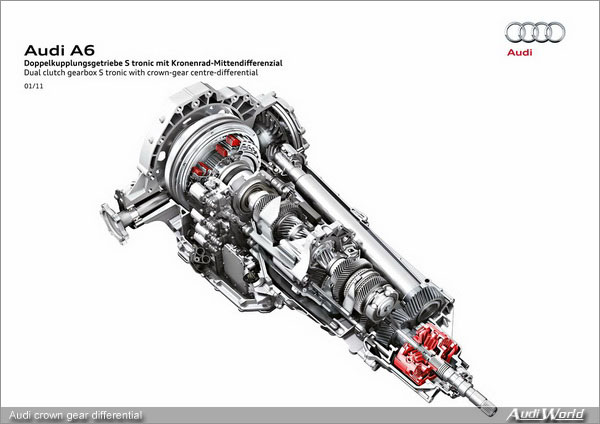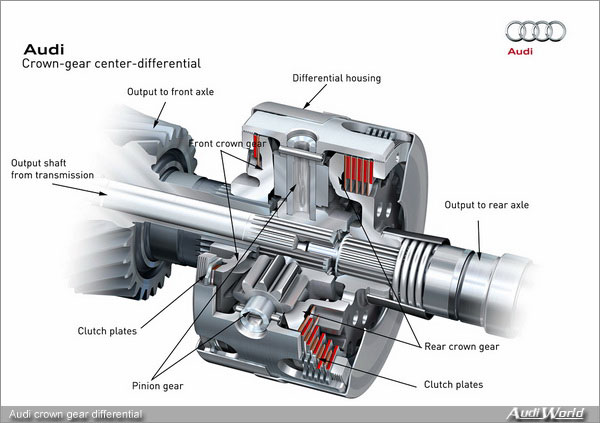December 12, 2011
Source: AudiWorld staff/Audi Media
The crown gear center differential replaces the previously used Torsen differential, which used a similar principal, but it acted in a completely different way, and was less adept at a rearward torque bias. The crown gear center differential makes the new Audi models which are equipped with the crown gear differential feel much more lively, and much more “rear wheel drive” than any Audi quattro model before, yet retain the same surefooted all weather stability at all times.

The next generation: quattro drive
The new A4, A5, A6, A7, Q5 and RS5 coupe from Audi are equipped with the next generation of the quattro permanent all-wheel drive system, featuring the crown-gear center differential and torque vectoring. Inside the new center differential are two rotating crown gears that owe their name to the crown-like arrangement of their teeth. The front crown gear drives the output shaft to the front differential, the rear crown gear drives the propshaft to the rear differential.
The crown gears mesh with four pinion gears inside of a drum like housing. They are arranged at right angles to each other and are driven by the transmission output shaft, which in turn drive the differential’s housing. Because of their special geometry, they have specifically unequal lever effects – in a nutshell, the crown gear to the rear axle is a larger working diameter than the front axle’s crown gear, while retaining the same gear ratio. To do this, Audi engineers position the actual teeth on the gear farther to the ouside edge on the rear crown gear, and closer to the center on the front crown gear. Normally 60 percent of the engine torque goes to the rear axle and 40 percent to the front.
Under normal driving conditions, the crown gears rotate at the same speed as the housing. If the torques change because one axle loses grip, different speeds and axial forces occur inside the differential, and the integrated plate packages are pressed together. The resulting self-locking effect now diverts the majority of the torque to the axle with the better traction. If the front axle begins to lose grip, up to 85 percent of the torque flows to the rear. If the rear wheels have less traction, up to 70 percent of the torque flows to the front axle.
With this extremely broad torque distribution range, the crown-gear differential surpasses its predecessors – traction becomes even better. Redistribution occurs with no lag and absolutely homogenously. The mechanical operating principle guarantees maximum efficiency and immediate response. Other strong points of the crown gear differential are its compactness and low weight – at 4.8 kilograms (10.58 lb) it is roughly two kilograms (4.41 lb) lighter than the previous unit. The propshaft is not bolted to the differential but rather latched to it, saving an additional 0.6 kilograms (1.32 lb) of weight.

|



